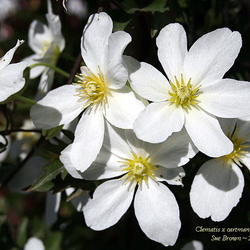| I bought an "Avalanche Evergreen Clematis" and it is NOT doing well. I paid ALOT of money for it. I followed directions on the tag. It is not growing, the leaves are dying, and it is in full sun until about 2pm. HELP! Place won't take it back either. I am NOT happy. Thanks. |
| Mine had a fantastic array of flowers but after flower drop, the foliage & stalks have gone brittle & look as though the plant is dead. It is planted in a 12 pot. Is this normal for the plant to die back after flowering, Or is it the compost, It is just standard potting type. Should I cut back the dead stalk ares?. |

The article gives the following suggestions for planting clematis vines. It says to dig a planting area with a depth of about 15 inches and width of about one foot. A mound of loose soil should fill the bottom so the roots will be about 2 inches below the surface of the soil when planted. Spread the roots over this mound and carefully tamp the soil into place. A trellis or plant stake should be positioned next to the clematis to provide necessary support. Thoroughly water the plant, and cover the surrounding soil with a ground cover such as mulch, bark, or straw. This will help protect the growing plant and help hold in valuable moisture. The article gives the following suggestions for maintaining clematis vines. It says they should be fed annually with a 15-5-5 fertilizer. Fully grown clematis vines may not require an annual feeding. However, they should be watered thoroughly once each week during periods of drought. Mulch should be replaced each spring to keep the roots cool. The most commonly occurring problem of the clematis vine is a devastating disease known as "wilt" which can affect the stems and leaves. Symptoms of this problem are weakened, limp stems and black foliage. Diseased stems and foliage should be removed along with the stems and foliage beneath the affected area. Clematis vines with this disease usually survive when affected sections are promptly removed. Wilt can affect the entire plant or just a few leaves. Sometimes the roots of the plant become diseased as well. With proper care and maintenance, clematis vines will provide years of lovely blooms. Their uniquely colored flowers,, some of which are fragrant, will add charm and beauty to your property. The clematis vine is truly a brilliant addition to a yard or garden. Hope the above information helps you determine just what is ailing your clematis so you can take appropriate corrective steps. Best wishes with your garden! |